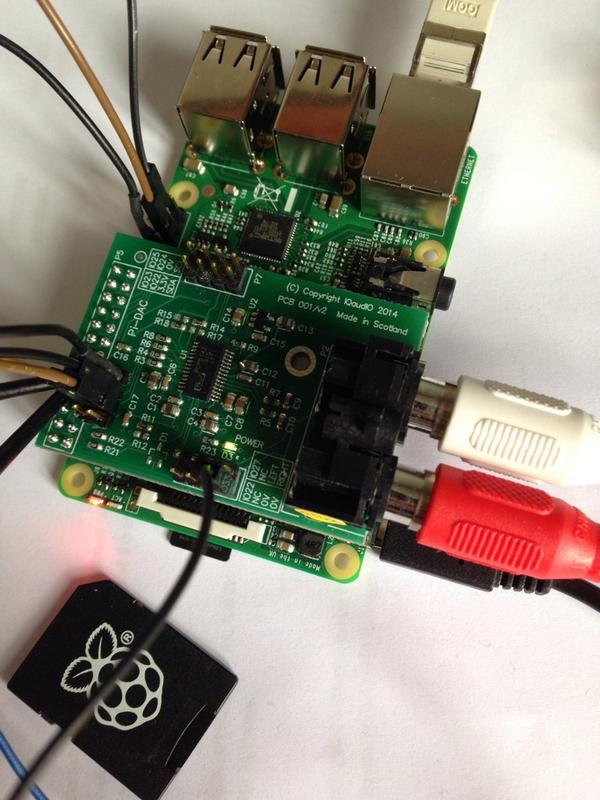I absolutely love Raspberry PI.
It somehow changed my life two years and a bit ago. Love the concept, love the mission, love the devotion of its creators. RaspyFi was born, like thousands of equal projects, thanks to this brilliant semiconductors pout-purri.
And, as everybody seems to know, today the new Raspberry Pi Model B+ has been announced. Let’s examine this from an Audio-centric perspective.
What has changed
First thing we notice: almost everything has changed its position: Power Connector, HDMI, Camera Connector, Analog Jack, USB Ports, GPIO Pins. And now the bad news: that means lots of Pi oriented accessories are not compatible with Raspberry Pi model b+.
Cases, Expansion headers, I2S DACs and lot more stuff will simply not fit. So, if you plan to use Raspberry Pi model b+ with your existing accessories, you’re just out of luck.
But, as always, the solution is just waiting for us at the end of a tunnel. I catched this tweet today from Gordon of IQaudIO, and what this clever scottsman is showing is that we can simply use connector cable to use i2s DACs also on Raspberry PI model b+.
Of course, 5 or 10 cm of i2s interconnect are less preferable than a soldered one, but it may have been worse. So, if you can accept such connection, you’ll be safe also with Raspberry Pi model b+.
Upgrades Overview
Quoting from the Foundation:
- More GPIO. The GPIO header has grown to 40 pins, while retaining the same pinout for the first 26 pins as the Model B.
- More USB. We now have 4 USB 2.0 ports, compared to 2 on the Model B, and better hotplug and overcurrent behaviour.
- Micro SD. The old friction-fit SD card socket has been replaced with a much nicer push-push micro SD version.
- Lower power consumption. By replacing linear regulators with switching ones we’ve reduced power consumption by between 0.5W and 1W.
- Better audio. The audio circuit incorporates a dedicated low-noise power supply.
- Neater form factor. We’ve aligned the USB connectors with the board edge, moved composite video onto the 3.5mm jack, and added four squarely-placed mounting holes.
Here’s what I think:
- More GPIO: Good move. I was short of GPIOs with Model B. And keeping the first 26 exactly the same was just the right thing to do.
- More USB: I can see this upgrade will benefit almost exclusively the ones using their PI as a Desktop Replacement (it clearly isn’t BTW). No need for a USB Hub, and final operating costs decreased for such targets. I just have one little, silly doubt. Since I struggled a lot with USB bus issues on the little PI I am quite worried about the performances of using multiple USB ports and Ethernet altogether. We are in the right direction with the USB fiq split fix, but this issue is still unresolved and its the main Pi’s design flaw. I don’t think people using their Pi for Audio purposes will benefit of that upgrade (unless you’re using a wlan stick, a USB Hard Drive and a USB DAC, but this is the kind of situation I’ll desperatly avoid with the little PI).
However, a valid addition no doubt about it. I’m just curious to see if internal power regulators can deliver a total of 2 A for 4 USB devices. I’ll investigate about that. - Micro SD: Yes, love it. Lot of times SD was just not working. Re-inserting it did the trick, changing to a push-push connection is the way to fix this.
- Lower Power Consumption: We are talking of 50% off. Ok, PI’s power consumption were already ridicoulously low, but knowing that Raspberry Pi model b+ has less power requirements is something to plaude.
- Better Audio: That was easy. Really, doing worst was the real challenge here. Raspberry Pi’s onboard jack was described with the worst words human has ever created. However, since we are choosy audiophiles we shouldn’t care lot about that. This can be interesting for something really cheap to play music and doesn’t really worry about Sound Quality.
Conclusions
Is this an upgrade? No, I would rather call it a sidegrade. But this adds flexibility to one of my favourite platform of all times (along with Sega Mega Drive) and could be an intriguing options for some Raspberry Pi owners. But, we should also consider that Raspberry Pi model b+ has several contenders (none really serious tough). So, if you really are looking for something more, you can have a significant upgrade just adding few extra bucks, without waiting for Raspberry Pi 2. I can think on the upcoming Hb-1 (or HummingBoard) from SolidRun. It has a substancially faster CPU and different from Raspberry PI model b+ is compatible with all Model b accessories (that’s quite ironic, isn’t it) [except i2s DACs, sadly]. Or UDOO, if you feel you’re a demanding maker and were using Arduino with the PI. Not to mention the Cubietruck, which has a massive set of I\Os.
So, if you’re looking for accessories compatibility, you’ll better stick with your current model b. If instead, you’re interested in the additional USB Ports and don’t care to wait for cases and accessories the Raspberry Pi model b+ could be your best bet.
That being said, someone in Florence will be ordering its Raspberry Pi model b+ in a matter of seconds.



